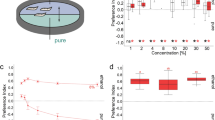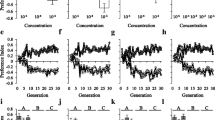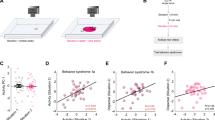Abstract
Wild-type (+B) and compound chromosome mutant(bB) Drosophila melanogaster larvae were tested in a U-maze. FreshDrosophila food or food and larvae were placed in each of the two goals (+B only in goal 1,bB in goal 2) and served as stimulus. Separate trials were conducted using +B andbB larvae to test for preference in the maze. Significantly more test larvae went to the arm of the maze containing their own strain as stimulus when (1) both goals contained larvae, (2) one goal contained homogenetic larvae and the other fresh food only, and (3) the goals contained biotic residues of stimulus larvae. The strength of the stimulus necessary to elicit the response differed for the two strains, the +B strain apparently being more sensitive. As the density of the stimulus larvae was increased, the choices of the test larvae became statistically nonsignificant and the number of larvae remaining in the starting arm of the maze increased. The data suggested that the strains of larvae utilized here have the capacity for olfactory discrimination.
Similar content being viewed by others
References
Averhoff, W. W., and Richardson, R. H. (1974). Pheromonal control of mating patterns inDrosophila melanogaster.Behav. Genet. 4:207–225.
Averhoff, W. W., and Richardson, R. H. (1976). Multiple pheromone system controlling mating inDrosophila.Proc. Natl. Acad. Sci. 73:591–593.
Barker, J. S. F. (1971). Ecological differences and competitive interaction betweenDrosophila melanogaster andDrosophila simulans in small laboratory populations.Oecologia (Berlin) 8:139–156.
Dürrwächter, V. G. (1957). Untersuchungen über Phototaxis und Geotaxis einigerDrosophila—Mutanten nach Aufzucht in verschiedenen Lichtbedingungen.Z. Tierpsychol. 14:1–28.
Ehrman, L. (1971). Natural selection for the origin of reproductive isolation.Am. Naturalist 105:479–483.
Ehrman, L. (1972). A factor influencing the rare male mating advantages inDrosophila.Behav. Genet. 2:69–78.
Ehrman, L. (1973). More on natural selection for the origin of reproductive isolation.Am. Naturalist 107:318–319.
King, J. A. (1970). Ecological psychology: An approach to motivation.Nebr. Symp. Motivation 18:1–33.
Leonard, J., Ehrman, L., and Pruzan, A. (1974). Pheromones as a means of genetic control of behavior.Ann. Rev. Genet. 8:179–193.
Lindsley, D. L., and Grell, E. H. (1968).Genetic Variations of Drosophila melanogaster, Carnegie Institution. Washington, D.C.
Parson, P. A. (1973),Behavioural and Ecological Genetics, Clarendon Press, Oxford.
Petit, C. (1972). Qualitative aspects of genetics and environment in the determination of behavior. In Ehrman, L., Omenn, G. S., and Caspari, E. (eds.),Genetics, Environment and Behavior, Academic Press, New York.
Petit, C., and Ehrman, L. (1969). Sexual selection inDrosophila. In Dobzhansky, T., Hecht, M., and Steere, W. (eds.),Evolutionary Biology, Appleton-Century-Crofts, New York.
Sewell, D., Burnet, B., and Connolly, K. (1975). Genetic analysis of larval feeding behaviour inDrosophila melanogaster, Genet. Res. 24:163–173.
Shorey, H. H., and Bartell, R. J. (1970). Role of volatile female sex pheromone in stimulating male courtship behaviour inDrosophila melanogaster.Anim. Behav. 18:159–164.
Author information
Authors and Affiliations
Additional information
Part of this investigation was supported by National Institutes of Health Award 1 F 32 NS05155-01 CMS from the Institute of Neurological and Communicative Disorders and Stroke to A. P.
Rights and permissions
About this article
Cite this article
Pruzan, A., Bush, G. Genotypic differences in larval olfactory discrimination in twoDrosophila melanogaster strains. Behav Genet 7, 457–464 (1977). https://doi.org/10.1007/BF01066781
Received:
Accepted:
Issue Date:
DOI: https://doi.org/10.1007/BF01066781




